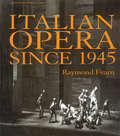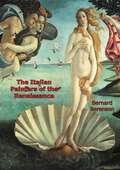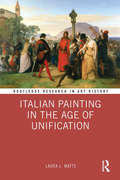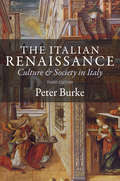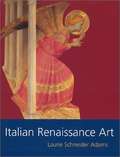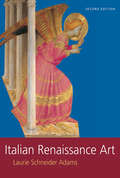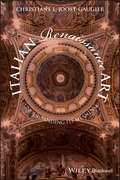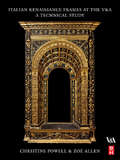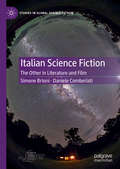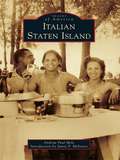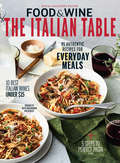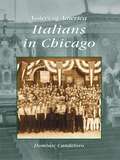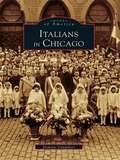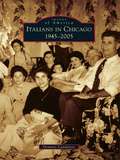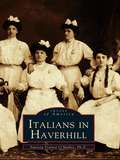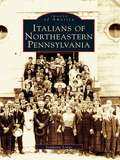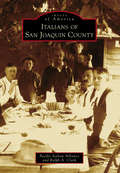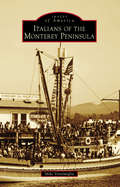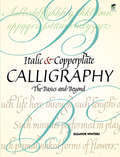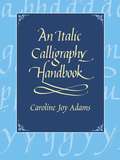- Table View
- List View
Italian Opera Since 1945 (Contemporary Music Studies #Vol. 15)
by Raymond FearnFirst Published in 1998. Routledge is an imprint of Taylor & Francis, an informa company.
The Italian Painters of the Renaissance
by Bernard BerensonImmerse yourself in the captivating world of Renaissance art with Bernard Berenson's authoritative and insightful book, "The Italian Painters of the Renaissance." Renowned as one of the foremost art historians of the 20th century, Berenson offers a profound and comprehensive analysis of the artists and masterpieces that defined this golden age of creativity and innovation.In "The Italian Painters of the Renaissance," Berenson meticulously examines the works of key figures such as Leonardo da Vinci, Michelangelo, Raphael, Titian, and Botticelli, among others. Through his erudite and engaging narrative, he explores the distinct styles, techniques, and contributions of these artists, shedding light on how they collectively transformed the art world and laid the foundation for modern Western art.Berenson delves into the historical and cultural context of the Renaissance, providing readers with a deeper understanding of the social, political, and philosophical currents that influenced these painters. He eloquently discusses the interplay between art and humanism, the revival of classical antiquity, and the burgeoning spirit of scientific inquiry that characterized the period."The Italian Painters of the Renaissance" is not just a study of art history; it is a celebration of the unparalleled genius and enduring legacy of Renaissance artists. Bernard Berenson's passion for the subject and his scholarly rigor shine through every page, offering readers a timeless exploration of one of the most dynamic and influential periods in art history.Whether you are an avid art lover or new to the subject, this book provides a comprehensive and inspiring overview of the Italian Renaissance, inviting you to appreciate the beauty and significance of its artistic achievements. Bernard Berenson's work remains a cornerstone in the study of Renaissance art, ensuring that the brilliance of this era continues to captivate and educate future generations.
Italian Painting in the Age of Unification (Routledge Research in Art History)
by Laura L. WattsItalian Painting in the Age of Unification reconstructs the artistic motivations and messaging of three artists—Tommaso Minardi, Francesco Hayez, and Gioacchino Toma—from three distinct regions in Italy prior to, during, and directly following political unification in 1861. Each artist, working in Rome, Milan, and Naples, respectively, adopted the visual narratives particular to his region, using style to communicate aspects of his political, religious, or social context. By focusing on these three figures, this study will introduce readers outside of Italy to their diversity of practice, and provide a means for understanding their place within the larger field of international nineteenth-century art, albeit a place largely distinct from the better-known French tradition. The book will be of interest to scholars working in art history, nationalism, Italian history, or Italian studies.
Italian Political Cinema: Figures of the Long ’68
by Mauro ResminiAn exploration of how film has made legible the Italian long &’68 as a moment of crisis and transitionTraditionally, the definition of political cinema assumes a relationship between cinema and politics. In contrast to this view, author Mauro Resmini sees this relationship as an impasse. To illustrate this theory, Resmini turns to Italian cinema to explore how films have reinvented the link between popular art and radical politics in Italy from 1968 to the early 1980s, a period of intense political and cultural struggles also known as the long &’68.Italian Political Cinema conjures a multifaceted, complex portrayal of Italian society. Centered on emblematic figures in Italian cinema, it maps the currents of antagonism and repression that defined this period in the country&’s history. Resmini explores how film imagined the possibilities, obstacles, and pitfalls that characterized the Italian long &’68 as a moment of crisis and transition. From workerism to autonomist Marxism to feminism, this book further expands the debate on political cinema with a critical interpretation of influential texts, some of which are currently only available in Italian.A comprehensive and novel redefinition of political film, Italian Political Cinema introduces its audience to lesser-known directors alongside greats such as Pasolini, Bertolucci, Antonioni, and Bellocchio. Resmini offers access to untranslated work in Italian philosophy, political theory, and film theory, and forcefully advocates for the continued artistic and political relevance of these films in our time.
The Italian Renaissance: Culture and Society in Italy, Third Edition
by Peter BurkePeter Burke presents a social and cultural history of the Italian Renaissance. He discusses the social and political institutions that existed in Italy during the fifteenth and sixteenth centuries, and he analyses the ways of thinking and seeing that characterized this period of extraordinary artistic creativity.
Italian Renaissance Art
by Laurie Schneider AdamsArt historian Laurie Schneider Adams brings to students a vibrant and engaging presentation of Renaissance art history that is supported by up-to-date scholarship and methodology. The text opens with the late Byzantine work of Cimabue and concludes with the transition to Mannerism. The author's focus is on the most important and innovative artists and their principal works, with a clear emphasis on selectivity and understanding. Italian Renaissance Art also focuses on style and iconography, and on art and artists, incorporating different methodological approaches to create a wider understanding and appreciation of the art. Distinguishing features of this text include: Over 400 illustrations, with 215 in full color, are integrated with the text, and large enough to properly view. In depth coverage on the most important and innovative artists and their principle works throughout Italy. Side boxes that provide additional material on techniques, biographical data, descriptions of artistic media, as well as necessary background information are used in every chapter. "Controversy" boxes introduce some of the ongoing scholarly quarrels among Renaissance art historians. Maps, plans, and diagrams are also included throughout. A historical chronology, a full glossary of art-historical terms, and a select bibliography are also included at the end of the text.
Italian Renaissance Art (Icon Editions Series #Second Edition)
by Laurie Schneider AdamsNow thoroughly revised and updated throughout, featuring extended discussions of Mannerism and the expanding role of women in the visual arts and significant illustration program enhancements, Italian Renaissance Art is a readable, student-friendly, lavishly-illustrated introduction to one of the greatest periods of artistic genius in western history.
Italian Renaissance Art
by Laurie Schneider Adams"The chronology of the Italian Renaissance, its character, and context have long been a topic of discussion among scholars. Some date its beginnings to the fourteenthcentury work of Giotto, others to the generation of Masaccio, Brunelleschi, and Donatello that fl ourished from around 1400. The close of the Renaissance has also proved elusive. Mannerism, for example, is variously considered to be an independent (but subsidiary) late aspect of Renaissance style or a distinct style in its own right."
Italian Renaissance Art: Understanding its Meaning
by Christiane L. Joost-GaugierRichly illustrated, and featuring detailed descriptions of works by pivotal figures in the Italian Renaissance, this enlightening volume traces the development of art and architecture throughout the Italian peninsula in the fifteenth and sixteenth centuries. A smart, elegant, and jargon-free analysis of the Italian Renaissance – what it was, what it means, and why we should study it Provides a sustained discussion of many great works of Renaissance art that will significantly enhance readers’ understanding of the period Focuses on Renaissance art and architecture as it developed throughout the Italian peninsula, from Venice to Sicily Situates the Italian Renaissance in the wider context of the history of art Includes detailed interpretation of works by a host of pivotal Renaissance artists, both well and lesser known
Italian Renaissance Frames at the V&A
by Christine Powell Zoe AllenThis visually stunning and technically detailed book is an in-depth analysis of the materials and techniques used on thirty eight of the V&A's Renaissance frames. The book will teach the reader to recognise frame style, structure and surface decoration of the period, as well as additions and alterations and later frames in the style. * First detailed technical analysis of the V&A's most important Renaissance frames * Highly illustrated with 100 + colour photos of front back and details, digital reconstructions, section profiles, and illustrations of frame types, joints and mouldings. * Provides a comparative reference for Renaissance frames in other publications Christine Powell has worked at the V&A since 1993. She is a Senior Furniture Conservator specialising in gilt wood European Furniture, mirror and picture frames. She has also worked at The National Gallery London for seven years as conservator working on European painted and gilt wood altarpieces and frames and The Wallace Collection for two years on European gilt wood frames and furniture. She has taught and published articles on the history, materials techniques and conservation of gilding. Christine studied furniture making and restoration of furniture at the London College of Furniture (latterly the Metropolitan University) including wood finishing, carving and gilding. Before this she worked in private practice for furniture restoration and special paint effects firms. She also attended Epsom School of Art and Design. Zoë Allen first joined the V&A in 2000 to work on gilt wooden objects for the British Galleries and returned to the V&A in 2003 where she has worked since as Frames and Gilded Furniture Conservator. Before joining the V&A full time she worked as a conservator for both public institutions, such as English Heritage, and private practices including projects at the Royal Academy, St Paul’s Cathedral and Somerset House. Zoë has published articles on her work. After a first degree in French Literature, Zoë studied conservation at the City & Guilds of London Art School. Her training covered the conservation of objects made from wood, stone and other sculptural materials, gilding and decorative surfaces. Internships included the National Institute for Restoration, Croatia, the Royal Collection, London and the Museum of London.
Italian Science Fiction: The Other in Literature and Film (Studies in Global Science Fiction)
by Simone Brioni Daniele ComberiatiThis book explores Italian science fiction from 1861, the year of Italy’s unification, to the present day, focusing on how this genre helped shape notions of Otherness and Normalness. In particular, Italian Science Fiction draws upon critical race studies, postcolonial theory, and feminist studies to explore how migration, colonialism, multiculturalism, and racism have been represented in genre film and literature. Topics include the role of science fiction in constructing a national identity; the representation and self-representation of “alien” immigrants in Italy; the creation of internal “Others,” such as southerners and Roma; the intersections of gender and race discrimination; and Italian science fiction’s transnational dialogue with foreign science fiction. This book reveals that though it is arguably a minor genre in Italy, science fiction offers an innovative interpretive angle for rethinking Italian history and imagining future change in Italian society.
Italian Staten Island (Images of America)
by Andrew Paul Mele James P. MolinaroThe great wave of European immigration in the late 19th and early 20th centuries brought more than four million Italians to America. It was one of the greatest mass emigrations in world history, and many settled in Staten Island. Following the opening of the Verrazano-Narrows Bridge in 1964, the island experienced another great influx of Italian immigrants, this time from the other boroughs of New York City. This new wave was responsible for doubling the island population by the year 2000. Italian Americans are evident in every avocation and in each corner of Staten Island society, with achievers in education, business, government, medicine, and sports and entertainment. Italian Staten Island chronicles the traditions, culture, and heritage of Italian Americans through more than 200 photographs.
The Italian Table (Food & Wine)
by The Editors of Food & WineThe editors of Food & Wine Magazine present Food & Wine The Italian Table.
Italians in Chicago: 1945-2005 (Voices of America)
by Dominic CandeloroThe stories of Chicago's Italian communities are an important part of the rich and diverse mosaic of Chicago history. As a rail center, an industrial center, and America's fastest growing major city, Chicago offered opportunities for immigrants from all nations. Italians in Chicago presents an intriguing narrative record of the earliest beginnings of Italian communities in the city, going back to the 1850s. It explores the lives of ten significant members of the Chicago Italian-American community.This book is a collaborative, cumulative effort, and gives glimpses and echoes of what occurred in the Italian-American past in Chicago. Including vintage images and tales of such individuals as Father Armando Pierini, Anthony Scariano, and Joe Bruno, and groups such as the Aragona Club and the Maria Santissima Lauretana Society, this collection uncovers the challenges and triumphs of these Italian immigrants.
Italians in Chicago: 1945-2005 (Images of America)
by Dominic CandeloroThe stories of Chicago's Italian communities are an important part of the rich and diverse mosaic of Chicago history. As a rail center, an industrial center, and America's fastest growing major city, Chicago offered opportunities for immigrants from all nations. Italians in Chicago presents an intriguing narrative record of the earliest beginnings of Italian communities in the city, going back to the 1850s. It explores the lives of ten significant members of the Chicago Italian-American community.This book is a collaborative, cumulative effort, and gives glimpses and echoes of what occurred in the Italian-American past in Chicago. Including vintage images and tales of such individuals as Father Armando Pierini, Anthony Scariano, and Joe Bruno, and groups such as the Aragona Club and the Maria Santissima Lauretana Society, this collection uncovers the challenges and triumphs of these Italian immigrants.
Italians in Chicago: 1945-2005 (Images of America)
by Dominic CandeloroMore than 25,000 Italian immigrants came to Chicago after 1945. The story of their exodus and reestablishment in Chicago touches on war torn Italy, the renewal of family and paesani connections, the bureaucratic challenges of the restrictive quota system, the energy and spirit of the new immigrants, and the opportunities and frustrations in American society. Drawn from scores of family albums, these intimate snapshots tell the story of the unique and universal saga of immigration, a core theme in American and Italian history.
Italians in Detroit (Images of America)
by Armando DelicatoPeople of Italian descent have been present in Detroit since Alfonso Tonti, second-in-command to Antoine Cadillac, participated in the founding of the city in 1701. By the close of the 19th century, the trickle of Italian immigrants had become a torrent, as thousands rushed to the growing industrial center. Settling on the lower east side, the community grew rapidly, especially north and east into Macomb County. Italians in Detroit did not remain in a "little Italy," but mingled with the diverse population of the city. Through a combination of hard work and strong family and community ties, the Italians of Detroit have achieved their dreams of a better life. They have met the challenges of living in a new land while nurturing the culture of the old country. The challenge that remains is to nurture a love ofheritage among young Italian Americans as the immigrant generation fades.
Italians in Haverhill
by Patricia Trainor O’malleyItalian immigrants became permanent residents of Haverhill in the 1870s. The original Genoese first drew their relatives and friends from their home area to join them. Over the next few decades, they were joined by families from the central province of Abruzzi and from the towns and villages around Naples. Immigrants from parts of southern Italy, such as Calabria and Apulia and Sicily, settled here. All of the Italians, whether northern or southern, brought with them their culture, their vitality, their love of music, and their close family ties. Using over two hundred thirty vintage photographs, Italians in Haverhill takes a photographic walk through the exciting history of these immigrants. The images bring back to life representatives of more than two hundred families, whose descendants still live in the area. Here are the fruit sellers and shoe workers, the mothers and their children, the ball players and the musicians, the lawyers and doctors, and the bankers and civic leaders who make up the rich heritage of this important ethnic group.
Italians of Northeastern Pennsylvania (Images of America)
by Stephanie LongoEvery Labor Day weekend, hundreds of thousands of people flock to Courthouse Square in Scranton for the largest ethnic festival in northeastern Pennsylvania: La Festa Italiana. The Italians of this region have been proudly celebrating their heritage since their arrival in this country with traditional festivals, including La Corsa dei Ceri in Jessup and Dunmore's procession in honor of St. Rocco. Using vintage and recent photographs, Italians of Northeastern Pennsylvania shows how the Italian immigrants to this area, some of whom arrived with little more than the clothes on their back, became well-respected community leaders. Through hard work and dedication, they have made northeastern Pennsylvania into an area that defines the term "ethnic pride."
Italians of San Joaquin County (Images of America)
by Ralph A. Clark Pacific Italian AllianceItalians were among the first European settlers in California, as fishermen from Italy arrived in the 1830s. After gold was discovered in 1848, immigrants from all over the world came for the opportunity that California presented. For the Italians, they encountered a terrain and climate so similar to their homeland that many stayed on to make California their new home. In San Joaquin County, the Italian influence remains profound, with the immigrants and their descendants helping develop the area's cultural, agricultural, and business climate into what it is today. The legacy of the Italian pioneers has enriched San Joaquin County in immeasurable ways. Every aspect of life here has been touched, molded, and made better by this industrious group who came to a distant land to make a better life.
Italians of Stark County (Images of America)
by J. A. MusacchiaImages of America: Italians of Stark County focuses on Italian immigration into Stark County beginning in the late 1800s. At the time, Stark County's urban hub of Canton and the surrounding communities were in the middle of a thriving expansion driven by industry, transportation, and manufacturing. Along with this growth came the need for labor, with immigration filling many of those needs. Italians came to Stark County to work in the steel mills, in the coal mines, and on the railroad, as well as to start their own small businesses. Once established, Italian families began to replicate the community foundations from their native land, and in turn these foundations reinforced embedded values: family, food, religion, music, and freedom.
Italians of the Monterey Peninsula
by Mike VentimigliaSince the early 1900s, Monterey was known for its fishing, mostly for salmon and the abalone that was plentiful in Monterey Bay. The migration of the Sicilian Italian community is credited for reaping what was called the "Silver Harvest." The Silver Harvest is the name that was given to the fishing of sardines in Monterey, which mostly was done by the Sicilian Italians who established the working fabric in the sardine industry for nearly five decades. Most of that generation is gone, and only a few are memorialized in books. It is this author's attempt to capture the working class that made Monterey the "Sardine Capital of the World."
Italic and Copperplate Calligraphy: The Basics and Beyond (Lettering, Calligraphy, Typography)
by Eleanor WintersIn recent years, calligraphy has evolved from an esoteric art form to an everyday pursuit for artists, students, and amateurs. This guide for novices with some experience offers the chance to advance to the next level. Well-illustrated, step-by-step instructions by an expert calligrapher explain every detail of the two most popular calligraphic alphabets. Author Eleanor Winters introduces the Italic hand, which originated during the Renaissance, and the Copperplate style, which dominated European calligraphy during the eighteenth century. Her three-part approach begins with a review of the basics, advancing to variations in letter size, form, weight, and flourishes. It concludes with a wealth of advice on layout and design as well as inspiration for original projects.
An Italic Calligraphy Handbook (Lettering, Calligraphy, Typography)
by Caroline Joy AdamsAn updated version of the classic Renaissance manuals, this handbook is geared toward modern practitioners. It features the best ideas from the early guides, compiled into a contemporary system that makes writing the Italic as simple as possible. With this manual as a guide, both experienced and novice calligraphers can cultivate their natural creativity.
The Italic People of Ancient Apulia
by T. H. Carpenter K. M. Lynch E. G. D. Robinson T. H. Carpenter K. M. LynchThe focus of this book is on the Italic people of Apulia during the fourth century BC, when Italic culture seems to have reached its peak of affluence. Scholars have largely ignored these people and the region they inhabited. During the past several decades archaeologists have made significant progress in revealing the cultures of Apulia through excavations of habitation sites and un-plundered tombs, often published in Italian journals. This book makes the broad range of recent scholarship - from new excavations and contexts to archaeometric testing of production hypotheses to archaeological evidence for reconsidering painter attributions - available to English-speaking audiences. In it thirteen scholars from Italy, the United States, Great Britain, France, and Australia present targeted essays on aspects of the cultures of the Italic people of Apulia during the fourth century BC and the surrounding decades.
